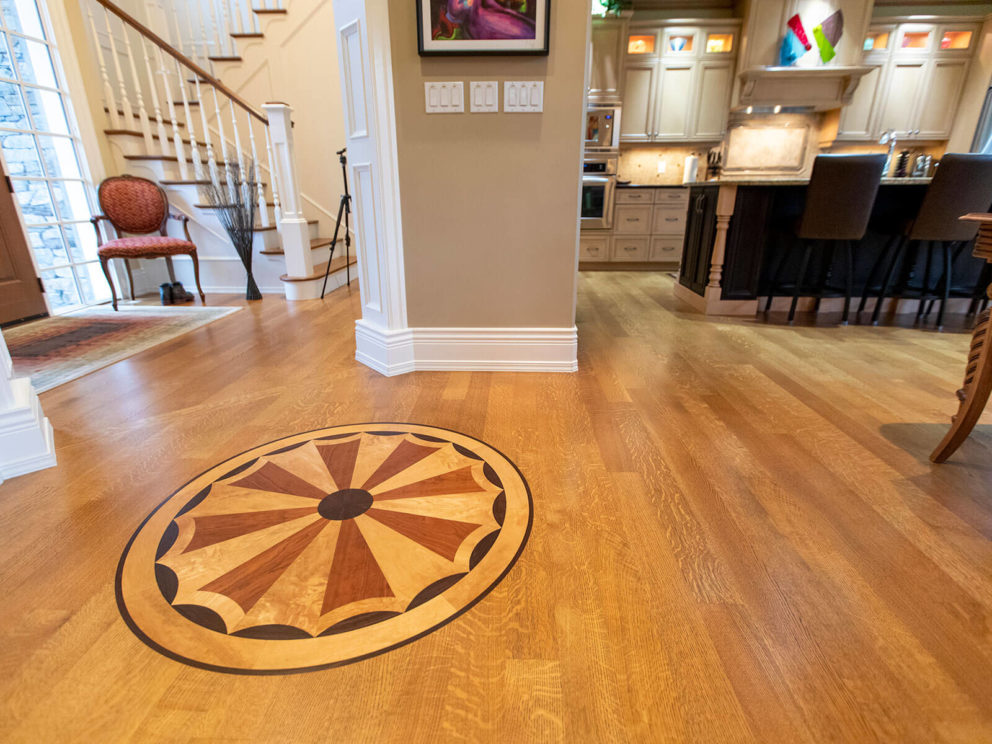
Yes. Wood is a natural product and therefore you will find variations in planks regardless of the grade of wood, species or colour.
No. Wood is a natural product and it will dent if enough pressure is applied. Please refer to our floor care guide to learn about how to properly care for your wood floors and how to avoid denting or damaging your floor.
Whether finished or unfinished, wood changes colour over time due to oxidation and exposure to light. Some species darken in colour over time, while others lighten. There is no set value for “colour fastness” of a species.
Although adhesive technologies have improved to the point of making this possible, we still recommend using the nail down method on solid wood floors. Solid wood has a tendency to have crooked or bowed boards, which make gluing difficult.
Yes, however, engineered floors over 5” in width may require the use of nails and glue, so be sure to follow the floor manufacturer’s instruction. Most manufacturers will also recommend what type/size of fastener to use.
It is always good to check the wood manufacturer’s instructions to see if they require a specific adhesive. If not, then ask our sales team which adhesive is right for your application.
Engineered is or should be, more dimensionally stable. As flooring has become wider engineered flooring has become more popular as they move less with seasonal change. With wide floors, it should be expected that some seasonal expansion or contraction will occur even if engineered flooring is used.
Humidity and temperature make all the difference in the performance of a wood floor, regardless of whether it is solid or engineered. Nearly every floor endures some separation between boards in winter. When homes are heated and the air is dry, wood loses its moisture and therefore shrinks. In the spring, as the heat is turned off, indoor environment increases in moisture content. Boards will also absorb moisture and expand, closing the gaps. Maintaining a constant humidity can help reduce these normal seasonal changes.
Acclimation is allowing the moisture content of the wood to adjust to “normal living conditions” at the site – that is, the temperature and humidity conditions that will typically be experienced once the structure is occupied.
The structure should be fully enclosed, with doors and windows in place, and interior climate controls should be operating for at least 48 hours to stabilize the moisture conditions of the interior. Wood should not be delivered if the job site moisture conditions are excessive. Otherwise, one will absorb moisture from the other.
Wood subfloors are actually easy to check for moisture content. Just test for moisture at several locations in the room and average the results. In most regions, a ‘dry’ subfloor that is ready to work on has a moisture content of 12 percent or less. If excessively high readings are obtained, installation should not proceed until the origin of the moisture is identified and moisture problems are remedied. During the winter, an overly moist subfloor can be dried out by running the heat for a few weeks. Air conditioning during the summer will do the same thing. Before flooring can be installed, the moisture content of the subfloor should be within 2-4 percentage points of the flooring that will be laid on it. If the moisture content between the flooring and subflooring varies more than 2-4 percentage points the flooring should not be installed.
As concrete moves through its initial drying period, regular checking of moisture content can start after 30 days. In most cases it will take 60 days or more before the slab is dry enough for wood flooring installation to proceed. Excess moisture in the concrete will cause problems such as condensation or failure of the adhesive under the flooring. Moisture conditions in concrete slabs that ultimately create moisture problems in flooring are not the flooring contractor’s responsibility, but it is the contractor’s responsibility to ensure that potential moisture problems are resolved before installation begins. A flooring contractor can begin his determination with some subjective and logical questions: What is the history of other homes in the area, as well as the history of the building, the quality of the building and the quality of the slab?
Also, what is the age of the concrete? (An installer should not accept a slab as “ready” on age alone.) What is the concrete’s visual appearance? (The colour of good, healthy concrete should be almost sugar-white. Any concrete that is gray, brown, tan or other such off-white colours should be suspected of having contaminants, admixtures or other problems unsuitable for flooring. It is virtually impossible, however, to judge a concrete slab’s moisture condition on the basis of colour alone.) Concrete slabs must meet a moisture specification when tested in accordance with the prescribed procedures, at the time of installation of the flooring, and also at any future date. The moisture specification shall be that the emission of moisture vapor from the floor shall not exceed 3 pounds per 1,000 square feet per 24 hours.
Concrete should normally be a minimum of 60 days old before wood flooring is installed on top, unless moisture testing indicates acceptable moisture content before that time. Anything short of that could result in moisture problems down the line. Rely on flooring manufacturers’ recommendations for your definition of what qualifies as “acceptable moisture content,” as well as for which type of moisture testing each manufacturer prefers. Testing for moisture in concrete can be accomplished using specially designed and calibrated moisture meters.